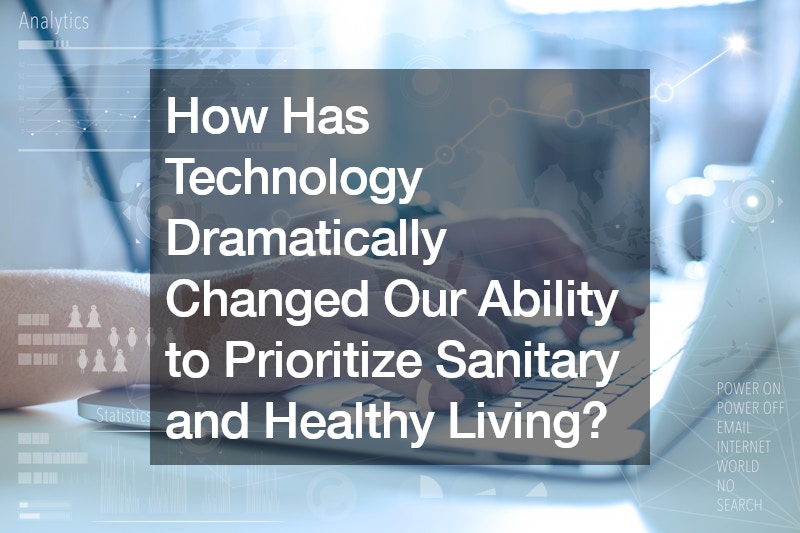How Has Technology Dramatically Changed Our Ability to Prioritize Sanitary and Healthy Living?

Technological changes are everywhere, affecting every industry we are involved in. The healthcare industry and how we keep ourselves healthy are no exception to those changes. Learning about these changes and adopting them as part of our wellness regime can make caring for ourselves easier. Here are some ways that technology is making changes to the ways we keep ourselves well:
Providing Clean Septic Systems
A septic system pumping company may not be pleasant, but they are necessary for our overall health. Some new developments in septic systems involve how the systems process wastewater. For example, some community systems now use pressurized dosing. Pressurized dosing uses a holding tank, and a pump controls the thickness and density of sewage as it is released through the system.
Some of the changes in the septic system are influencing the septic processing stage, called the leach field. The leach field is the last phase of the septic system; it is where the wastewater is filtered before it is released into the soil. In two of the newer methods, wastewater filtration through the leach field is dramatically changed by new technology. Smaller buildings now use plastic chamber leach fields – specially designed for smaller volumes of water.
Sand is one of the main features of another new development in septic system technology. Sand and aerobic bacteria pre-treat wastewater before it goes through the system. Pre-treating the sewage will begin filtering before it reaches the leach field. With this much of a head start on filtration, the water is processed more quickly and emerges in a less contaminated state than previous systems would allow.

Processing Grain in New Ways
Grain pumps use a pumping system to transport grain from one place to another – for storage, transport, and processing. A typical grain pump uses air or water pressure to move the grain gently without damaging it. One innovation on the device uses an electric drive to reduce some of the common problems activating grain pumps.
The electric drive pump uses the traditional force of gravity, funneling grain from a high surface to a collecting device. However, it has been updated by an electric motor, which speeds up grain processing. If you have more than one location where grain is collected, you can move all of them at once with a round tube conveyor. The tube will gather the grain from multiple sites and then move it downward to a standard collection device.
The increased speed with which these methods are making grain available created an initial problem of its own. Although grain was available, distribution methods weren’t efficient, and people who needed grain could not access it. According to WFPusa, humanitarian efforts are now centered on providing a dramatically changed form of distribution: a “smart card” for each family who needs surplus grain. With these cards, the family can access their monthly allotment of grain without going through an intermediary.
Replacing Gas Stoves and Furnaces
Although today’s newsmakers have been writing negative stories about gas stoves, the government has not yet forbidden using gas stoves or furnaces. New regulations for using gas-powered appliances have emerged. Gas companies and their consumers must now adhere to these new regulations.
According to Politico, a study showed that homes with gas stoves had a higher incidence of respiratory diseases. The same survey reported testing results that showed a higher level of indoor air pollutants. The study equated indoor air quality after using gas appliances to the level of risks caused by secondhand smoke. Today’s authorities recommend electric stoves as an alternative, as they reportedly have less tendency to produce as high a level of respiratory issues.
According to Angi, using gas furnaces indoors puts you at risk of carbon monoxide poisoning. The same website cautions users of gas furnaces to keep 80% of their air vents open to have enough air circulating around the home. If you notice the heater keeps turning on and off frequently, the furnace may be broken. Owners of gas furnaces must have a carbon monoxide detector in the home and keep the monitor’s batteries fresh.

Disposing of Cooking Oil
When you cook fried food with cooking oil, you probably know pouring the oil down the drain is unsafe. Grease can clog drains or coat your dishes and utensils in grease, and if you pour the oil down the toilet, it can clog your septic system. Find a safe container to pour the grease into and then allow it to solidify. According to Green Citizen, add some cat litter or coffee grounds to the fat to help it solidify more quickly, and then you can easily discard the solidified clump.
According to Consumer Reports, a company has developed a product called Fry Away to help home cooking oils solidify more quickly. The product is a powder similar to stearic acid added to cooking oil to solidify it more quickly. The solid cooking oil will clump, allowing it to be safely discarded.
Some contractors provide cooking oil disposal services for establishments that use large volumes of cooking oil, such as restaurants. Restaurants contract with a cooking oil disposal service to dispose of their oil regularly. According to Consumer Reports, government research now hopes that future oil disposal will be dramatically changed. Research is being done to determine if these large oil collections can be converted to biofuel.
Keeping Your Chimney Clean
Chimney cleaning has always been a practice that puts the cleaner at risk of breathing sooty air. Today, a home with a chimney will likely have a flue liner (also called a chimney liner) to keep the home’s air healthier. The liners are intended to absorb hazardous gases (like creosote and soot) created when the chimneys burn fuel. The chimney liner has dramatically changed the safety level for families with a chimney in their homes.
In addition to absorbing harmful gases, these flue liners will keep the chimney from overheating. Since this regulates the heat level, it will prevent the chimney from corroding or aging too quickly. When the chimney cleaning company arrives at your home, having these liners in the chimney will make it easier for their contractor to clean it.
Because of the cleaner air inside the chimney, there will be better and healthier air exchange. The healthier and cleaner air exchange will also allow you to burn your fire with less fuel, saving you money. The continuously healthier exchange also reduces the risk of carbon monoxide poisoning and fire from accidental blockage in the chimney.

Receiving New Dental Implants
The dentist typically suggests using a dental implant when an adult tooth is pulled or lost. A person’s ability to chew will be compromised without a dental implant. Dental implants will also provide a more normal appearance for the person whose tooth is missing. A new method of making dental implants is now being explored with 3-D printing.
In addition to these dramatically changed dental implant methods, new technologies are being developed to measure the implants before they are created. According to a LADentist, measurements are made using digital imaging. Those computers can give a much more accurate measurement to ensure a precise fit for the implant.
The same digital imaging that can precisely measure the client for implants can also be used inside the mouth. This activity would precisely guide the placement of the implant. Implants are typically created in dental labs using porcelain or other materials. However, new research is being done to produce dental implants which will allow the creation of the implant while you are still at the dental office.
Maintaining Flowing Water
Water is a valuable resource in your home. New advances in plumbing are more frequently focused on reducing homeowners’ water use. One of those advances is a touchless faucet, which will save water. When those faucets are in use, users can pass their hands underneath them. Once a motion sensor inside the faucet detects someone’s hands, the sensor will prompt the faucet to release the water flow.
Similar technology now exists for toilets. When contactless toilets are used, motion detectors activate bathroom lights, flushing, and self-cleaning. Low-flow toilets are also in use, saving the amount of water used when toilets are flushed and refilled. Although these changes had previously been featured more often in public places or commercial buildings, they are now available at home.
Your plumbing will typically include a water heater for your sinks and tub. Many homes today use tankless water heaters, which keep the water ready for use but only begin to heat the water once a faucet is turned on. The above changes to your home’s plumbing system will require the assistance of a trained plumber with experience with the new technologies.
Unclogging Clogged Drains
If you have a clogged drain at home, call a plumber to unclog it. If they have difficulty removing the clog, the plumber may use drain jetting. According to TrusteyMate, drain jetting uses a high-powered water jet to force the clog to resolve. Drain jetting is considered eco-friendly because it uses only water and no harsh chemicals.
These systems are being developed with the hope that they can soon be used for community sewer management or industrial purposes. Advances being considered include automation, which would implant these systems in community sewers. This implantation would include drain jetting at regular intervals and keeping the community water systems clear. If more energetic cleaning is needed, robotic plumbers can navigate the pipes to complete the cleaning required.
Remote monitoring can be used in systems without scheduled jetting. This proactive approach to pipe maintenance will dramatically change the cleaning routine. Drain jetting can now be done with recycled water to improve the eco-friendly nature of the plumbing systems.
Coming Home to a Warm Environment
Keeping your home warm in the winter and cool in the summer is an essential comfort measure. The system in your home that controls your heating and air conditioning is called your HVAC system. You must have an annual HVAC inspection to find out if there are any changes you can make to keep your home comfortable. Just as it has for many other systems, technology has also dramatically changed the HVAC system.
According to Joplin, water faucets aren’t the only things that will now be activated by sensing hand movements. The same website reports that MIT has developed air conditioners activated by hand motions. This not only means convenience; it means the energy for the air conditioner is only used when someone is in the room. As an alternative, air conditioners are set only to turn on when the room air is at a specific temperature.
One of the most dramatic modern developments has come from a company that can use a 3-D-printed brick-shaped device. This device can draw moisture from the air and cool it, using that cooler temperature to influence the surrounding air. Home heating controls are being developed with intelligent sensors and thermostat control. In the future, some companies hope to use the energy of our motions in the computer to produce heat energy to supply your home’s heat.

Delivering Healthy Water
If you have a working well on your property, you will want a well pump to bring fresh water to your home. You may work with a well pump services company to keep your well in good working order. If so, you might ask them which new technology may make your water pumping easier or quicker for your family.
Since your well begins outside your home, it may be easy to imagine the existence of a solar-powered well pump. The sunshine is there for the taking and shines directly on the well. Another option could be to connect your well to the intelligent hub in your home. This will involve installing sensors within your pump and its water to remotely monitor the water level and composition.
As you can see, technology has dramatically changed many systems that routinely improve your environment, home, and personal health. You may not need all of these new systems. However, by becoming aware of them, you may make minor technological changes to the systems in and around your home. Knowing about these changes now may help you be ready for them in the future.



